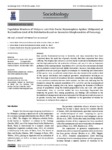Please use this identifier to cite or link to this item:
http://www.alice.cnptia.embrapa.br/alice/handle/doc/1010023| Title: | Population structure of Melipona ssbnitida Ducke (Hymenoptera: Apidae: Meliponini) at the southern limit of its distribution based on geometric morphometrics of forewings. |
| Authors: | LIMA, C. B. S.  NUNES, L. A.   RIBEIRO, M. de F.   CARVALHO, C. A. L. de   |
| Affiliation: | C. B. S. LIMA, Universidade Federal do Recôncavo da Bahia, Cruz das Almas, BA; L. A. NUNES, Universidade Estadual do Sudoeste da Bahia, Jequié, BA; MARCIA DE FATIMA RIBEIRO, CPATSA; C. A. L. DE CARVALHO, Universidade Federal do Recôncavo da Bahia, Cruz das Almas, BA. |
| Date Issued: | 2014 |
| Citation: | Sociobiology, v. 61, n. 4, p. 478-482, dec. 2014. |
| Description: | Bees provide fundamental services to humanity, and many researchers have been concerned about the rapid loss of genetic diversity that these organisms have been suffering. The stingless bee Melipona subnitida Ducke is endemic to Northeastern Brazil and has high potential for the production of honey and wax; it is also an important pollinator in the Caatinga biome. Populations of M. subnitida have increasingly declined due to predatory extractivism and habitat destruction. However, knowledge about its population structure could give insights on strategies for monitoring and conservation of this species. Here we collected workers from nine sites located at the southern limit of the species distribution and employed geometric morphometric techniques on their forewings in search of covariance between sampling site and wing morphology. A very significant correlation between both variables was observed, indicating that the divergence among the sampled populations of M. subnitida was due to geographical distance among the sampling sites and, hence, suggesting the formation of different groups of populations along the studied geographical zone, each one with specific characteristics. Since M. subnitida habitat has been increasingly fragmented thus hindering the genetic flow among populations, our findings will contribute to the formulation of management and conservation plans for this species in order to preserve its genetic diversity and, therefore, to collaborate to the generation of income for beekeepers in meliponiculture programs. |
| Thesagro: | Abelha Inseto Polinização |
| Keywords: | Abelha Jandaíra Meliponicultura Abelha sem ferrão Morfometria de asas dianteiras Insect Bee |
| DOI: | 10.13102/sociobiology.v61i4.478-482 |
| Type of Material: | Artigo de periódico |
| Access: | openAccess |
| Appears in Collections: | Artigo em periódico indexado (CPATSA)  |
Files in This Item:
| File | Description | Size | Format | |
|---|---|---|---|---|
| Marcia2014.pdf | 494.29 kB | Adobe PDF |  View/Open |









